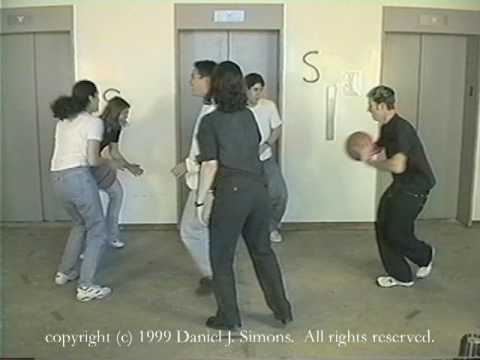1.4.1: Concentration and Distraction
- Page ID
- 25704
original content by Dave Dillon
concentration. n. exclusive attention to one object.
– dictionary.com
Where To Study
In order to study successfully, students must learn to concentrate at a high level. It is important to know where we study best. Some students study well at home. Other students study well at a library or coffee shop. There is no best for all. Your best environment is based on you and your preferences.
Directions: Watch this selective attention test video and see if you come up with the correct answer.
Video: Selective Attention Test, Daniel Simmons
When To Study
It is also important to know when we study best. Many students are most efficient studying in the morning when they are fresh. Studying late in the day may be the only option for some students but often we are tired at the end of the day, and this can have a major effect on study efficiency. Figuring out where and when we study best may take some time. And even when we find the best place and time to study, we also have to be aware of distractions, which can be internal or external.
Internal Distractions
An internal distraction includes thought processes, self-esteem, or confidence. It’s something that interrupts you from what you’re doing. It might also be a computer or cell phone – something that is controlled by you. Many students intend to study but easily get distracted with surfing the Internet, checking social media, watching YouTube videos, or receiving a text message. If you don’t absolutely need your computer or cell phone for your study, it is my suggestion to not bring them or turn them off. If you do study with your phone or computer, it is best to have all potential alerts turned off. Notifications of text messages, emails, or social media updates all can serve as a major distraction to your studying.
External Distractions
External distractions might be your roommates, family or friends. Even if they are supportive of your study, it may be challenging to concentrate when they are around. Saying “no” is an important skill that may need to be utilized in order for you to have your study time without interruption.
Keep in mind that it may take 20 minutes to reach a high level of concentration. When we are interrupted, it takes on average another 23 minutes to get back to the level of concentration that we were at prior to the disruption.[1] If a student is studying for an hour and is interrupted twice, the consequence to study efficiency is devastating.
One way to try to monitor how many interruptions you incur and how well you maintain your level of concentration is to keep track of it. Take a blank piece of paper when you are studying and mark down each time you were interrupted.
Over time, with practice, you should be able to decrease the number of interruptions you incur. This will allow you to be most efficient when studying.
Multitasking
Millennials are considered extraordinary multitaskers, though brain science tells us that multitasking is a myth[2]. More likely, they are apt to switch tasks quickly enough to appear to be doing them simultaneously. When it comes to heavy media multitasking, studies show greater vulnerability to interference, leading to decreased performance[3].
My classes have had lively discussions on multitasking. Most of the time, I am able to convince students that multitasking is not a good idea for them. (There are always a few stubborn hold outs). Trying to do multiple things at the same time may seem like it may allow you to accomplish more but when studying it often leads to accomplishing less. There are things that I think can be successfully multitasked. I could throw clothes in the washer and make a snack, then eat and read a book at the same time while waiting for the clothes to be washed. But if I try to text, check e-mail, watch TV and look at my Twitter timeline all while studying, it won’t work well.
A study from Carnegie Mellon University found that driving while listening to a cell phone reduces the amount of brain activity associated with driving by 37 percent[4]. Why would anyone choose to use less brain activity when they study?
EXERCISE 1: What's Your Distraction?
Directions: Below is a list of common distractions for college students. Rank these distractions on a scale of 0 to 5, with 5 being a an extreme distraction. There are even two blank rows for you to fill in other distractions that may not be listed below.
| 0 | 1 | 2 | 3 | 4 | 5 | |
|---|---|---|---|---|---|---|
|
||||||
|
2. Other people around you |
||||||
|
3. Worrying about work, school, family/personal issues |
||||||
|
4. Tiredness/Lack of energy |
||||||
|
5. Hunger |
||||||
| 6. Lack of interest in the subject or task | ||||||
| 7. Stress/feeling overwhelmed | ||||||
| 8. Noise | ||||||
| 9. Room lighting | ||||||
| 10. Room temperature | ||||||
| 11. (other) | ||||||
| 12. (other) |
created by Laura Gilbert
EXERCISE 2: Let's Minimize Your Distractions
Directions: Choose your top three distractions from the exercise above and conduct an Internet search to find articles to help minimize those top three distractions. List those distractions and potential solutions below.
| Distractions | Potential Solutions |
|---|---|
| 1. | |
|
2. |
|
|
3. |
created by Laura Gilbert
Licenses and Attributions:
Content previously copyrighted, published in Blueprint for Success in College: Indispensable Study Skills and Time Management Strategies (by Dave Dillon), now licensed as CC BY Attribution.
Adaptions: Reformatted, some content removed to fit a broader audience.
All rights reserved content:
Selective Attention Test. Authored by: Daniel Simmon. Located at: https://www.youtube.com/watch?v=vJG698U2Mvo. License: All Rights Reserved. License Terms: Standard YouTube license.
- Gloria Mark, Daniela Gudith, and Ulrich Kiocke, “The Cost of Interrupted Work: More Speed and Stress,” 2008, https://www.ics.uci.edu/~gmark/chi08-mark.pdf. ↵
- Jim Taylor, “Technology: Myth of Multitasking,” 2011, Psychology Today, http://www.psychologytoday.com/blog/...h-multitasking. ↵
- Eyal Ophir, Clifford Nass, and Anthony D. Wagner, “Cognitive Control in Media Multitaskers,” Proceedings of the National Academy of Sciences of the United States of America, 2009, http://www.pnas.org/content/106/37/15583.full. ↵
- Byron Spice, Timothy Keller, and Jacquelyn Cynkar, “Carnegie Mellon Study Shows Just Listening To Cell Phones Significantly Impairs Drivers,” (Pittsburgh, PA: Carnegie Mellon, 2008). ↵



